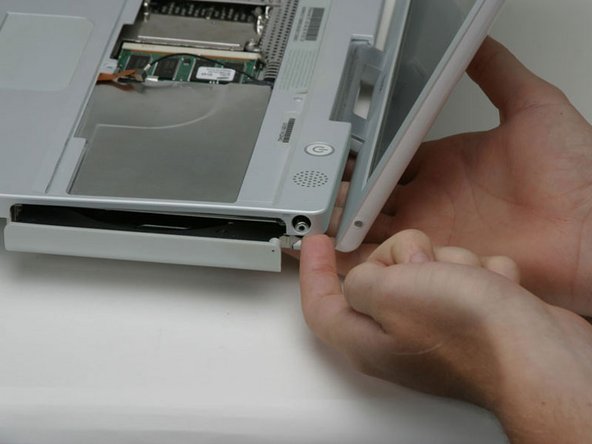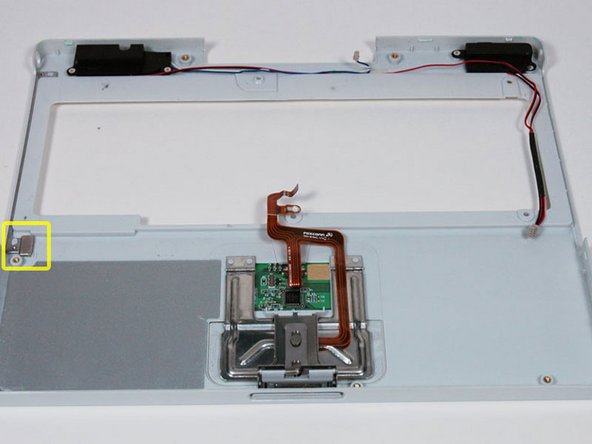iBook G3 12" Hard Drive Replacement
ID: 131
Description: You can install hard drives up to 9.5mm thick.
Steps:
- Use a coin to rotate the battery locking screw 90 degrees clockwise.
- Lift the battery out of the computer.
- Pull the keyboard release tabs toward you and lift up on the keyboard until it pops free.
- If the keyboard does not come free, use a small flathead screwdriver to turn the keyboard locking screw 180 degrees in either direction and try again.
- Flip the keyboard over, away from the screen, and rest it face-down on the trackpad area.
- If the computer does not have an Airport card installed, skip the next two steps.
- Push the wire clasp toward the Airport card and pull it up to free it from the RAM shield.
- Grasp the clear plastic tab on the Airport card and pull toward the right.
- Hold the Airport card in one hand and use your other hand to remove the antenna cable.
- Remove the two 2.5 mm Phillips screws that secure the RAM shield.
- Grasp the metal bracket on top of the RAM shield and pull upward to remove the shield.
- Pull the keyboard cable up from the logic board, holding the cable as close to the connector as possible.
- Your laptop should look approximately like this.
- Use a pin (or anything you like) to remove the three rubber feet from the lower case.
- Remove the three 5.2 mm newly-revealed Phillips screws.
- Use a spudger or small flathead screwdriver to pry up the three metal rings that housed the rubber bumpers.
- Remove the one 10 mm and two 20 mm hex screws using a 2mm hex. Alternatively, a T8 Torx screwdriver key will do.
- Remove the two 4.2 mm Phillips screws on either side of the battery contacts.
- Breathe deeply. Trying times are ahead, but we promise the lower case does come off.
- Push the thin rims of the lower case surrounding the battery compartment in, bending them past the tabs, and then lift up to free that corner of the lower case.
- There is a slot on the wall of the battery compartment that locks the lower case in place. Use a small flathead screwdriver to pry out the slot's lower rim and pull up on the lower case to free the slot from the tabs holding it.
- Run a spudger along the seam between the lower case and upper case on the front of the computer to free the tabs locking the lower case. Pull up on the lower case and continue to use the spudger as necessary until you hear three distinct clicks.
- Continue to run the spudger around the front, right corner. There are two tabs on the port side of the computer, one near the front corner and one near the sound out port.
- Once the front and sides of the lower case are free, turn the computer so that the back is facing you and pull the lower case up and toward you until the back tabs pop free (it may be helpful to jiggle the case up and down).
- Remove the small greasy springs with white plastic caps from either side of the battery contacts.
- Remove the following 4 screws on the bottom of the computer:
- Two 3 mm Phillips from the left side of the computer.
- One 4.5 mm Phillips near the latch mechanism (this screw may be missing in 800 MHz iBooks)
- One 14.2 mm Phillips near the front, right corner.
- Use a straightened paperclip to open the optical drive tray.
- Pull the optical drive out just enough so that you can access and remove a Phillips screw near the battery compartment.
- Pull the optical drive a bit more so that you can access and remove a second Phillips screw near the power receptacle.
- Turn over the computer and open it.
- Use tweezers (or a refrigerator magnet) to remove the magnet covering a Phillips screw near the middle of the computer.
- Remove the following 4 screws on the edges of the keyboard area.
- One 4.5 mm Phillips underneath where the magnet was.
- Three 6 mm Phillips in plastic depressions.
- Peel up the foil tape covering the speaker cable near the ports.
- This is a diagram of the trackpad ribbon clamp connector you will disconnect in the next step.
- 1) With your fingernails, grasp the locking bar on either side and pull up a small amount (about 1/16" or 2 mm).
- 2) After disengaging the locking bar, slide the cable out of the connector.
- Loosen the trackpad connector by pulling the top piece up slightly, freeing the trackpad ribbon.
- Slide the orange trackpad ribbon out of the connector.
- Before you can jerk the upper case off with joy, you must disconnect both the blue and white power cable and red and black speaker cable as described in the next steps.
- Lift the upper case from the left side and use your other hand to pull out the right side in order to clear the power receptacle.
- There may be a thin metal bar fastened to the upper case by the two screws on either side of the optical drive. This bar provides rigidity around the optical drive; don't forget it when reassembling.
- The connectors at the ends of the cables are attached very firmly to the sockets on the logic board. Pulling directly on the cable will either separate the cable from its connector or the socket from the logic board.
- Lift the upper case enough to disconnect the blue and white power cable from the logic board. Using your fingernails or a dental pick, carefully pry the connector from its socket. Make sure you're pulling only on the connector and not on the socket.
- Lift the upper case off completely and disconnect the red and black speaker cable from the logic board. As before, make sure you're pulling only on the connector and not on the socket.
- There is a magnet that allows the computer to detect when the laptop is closed. If this magnet is not present your computer will not automatically go to sleep. Be sure the magnet is in the position indicated.
- Your laptop should look approximately like this.
- Remove the following 14 screws (some models may be missing a couple of screws):
- One 2.5 mm Phillips.
- Six 3.5 mm Phillips.
- One 4.5 mm Phillips near the sleep light with a small shaft.
- Two 4.5 mm Phillips with larger shafts.
- Four 5 mm Phillips
- If a screw is inserted in the left hole, the 14.2 mm screw in step 24 can not be inserted to hold the top case down.
- Peel back three strips of yellow tape in the bottom left corner.
- Peel back one strip of foil tape in the upper left corner and another near where the trackpad connects to the logic board.
- Lift the top shield up from the right side, minding the upper left corner, which may catch on the metal framework.
- Your laptop should look approximately like this.
- Use the transparent orange loop to disconnect the large orange ribbon cable from the logic board.
- Lift up the front edge of the hard drive.
- Peel back the black tape to free the microphone cable from the hard drive.
- Use the transparent orange loop to disconnect the hard drive ribbon cable from the hard drive.
- This is a bit tricky. Try rocking the cable gently from side to side while applying even pressure. If you bend the pins, do your best to straighten them, using the hard drive cable as a guide.
- Your laptop should look approximately like this.
- Your hard drive should look approximately like this.
- Remove the metal brackets from either side of the hard drive (if they're still there).
- With the pins facing away from you, and the label facing up, the bracket with a tab in the middle and a metal slot on it goes on the left side of the drive; the other bracket, of course, goes on the right.
- Remove two T8 Torx screws from either side of the hard drive (four screws total).











































